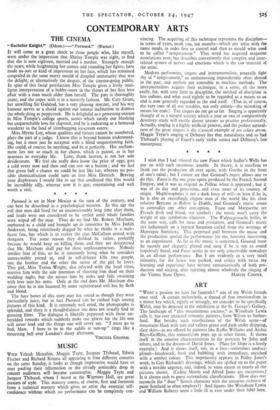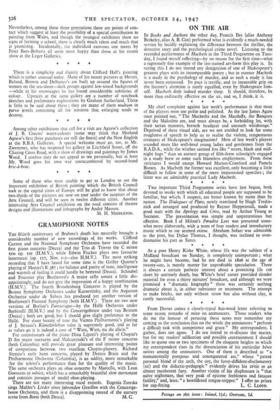ART
" WHAT a passion we have for funerals! " one of my Welsh friends once said. A certain melancholy, a thread of that emotionalism in a minor key which, rightly or wrongly, we consider to be specifically Welsh, may be detected in the exhibition at the St. George's Gallery. The landscape of " this mountainous enclave," as Wyndham Lewis calls it, has ever attracted romantic painters, from Wilson to Suther- land. But besides such recollections of the Welsh scene—of mountains black with rain and valleys green and dank under dripping, slaty skies—as are offered by painters like Kyffin Williams and Archie Rhys-Griffiths, this romanticism pops up in other forms. It shows itself in the emotive characterisation in the portraits by John and others, and in the dreams of David Jones. (Place for Ships is a lovely example.) And it shows itself, too, in a free—sometimes undisci- plined—brushwork, fresh and bubbling with immediacy, enriched with a sombre colour. This impetuosity appears in Petley Jones's work, in Ceri Richards's drawings, which are spilled on to the paper with a terrible urgency, and, indeed, to some extent in nearly all the pictures shown. (Cedric Morris and Alfred Janes are exceptions.) It is always rash to press nationalistic classifications. (How does one reconcile the " dour " Scotch character with the sensuous richness of paint Scotland so often employs?) And figures like Wyndham Lewis and William Roberts seem a little ill at ease under their label here.
Nevertheless, among these three generations there are points of con- tact which suggest at least the possibility of a special contribution to painting from Wales, and though the youngest exhibitors show no signs of forming a school, there is clearly much talent and much that is promising. Incidentally, the individual canvases one meets by Peter Rees-Roberts all seem more happy than those at his recent show at the Leger Galleries.
* * * *
There is a simplicity and dignity about Clifford Hall's painting which is rather unusual today. Many of his recent pictures at Messrs. Roland, Browse and Delbanco's are built up around the figures of women on the sea-shore—dark groups against low-toned backgrounds —while in his snowscapes he has found considerable subtleties of colour. Upstairs at the same gallery are a number of notebook sketches and preliminary explorations by Graham Sutherland. There is little to be said about these ; they are many of them muhum in parvo jewels containing all the tensions that enlarging tends to destroy.
Among other exhibitions that call for a visit are Agnew's collection of J. R. Cozens' water-colours (some may think that Morland Agnew's first three purchases are still the finest) and the New English at the R.B.A. Galleries. A special welcome must go, too, to Mr. Zwemmer, who has reopened his gallery in Litchfield Street, off the Charing Cross Road, with a show of drawings and paintings by James Wood. I confess they do not appeal to me personally, but at least Mr. Wood goes his own way unencumbered by second-hand bric-a-brac.
* * * *
Some of those who were unable to get to London to see the important exhibition of British painting which the British Council took to the capital cities of Europe will be glad to know that about two-thirds of the pictures are now on tour under the auspices of the Arts Council, and will be seen in twelve different cities. Another interesting Arts Council exhibition on the road consists of theatre designs and illustrations and lithographs by Andre Masson.
M. H. MIDDLETON.

































 Previous page
Previous page